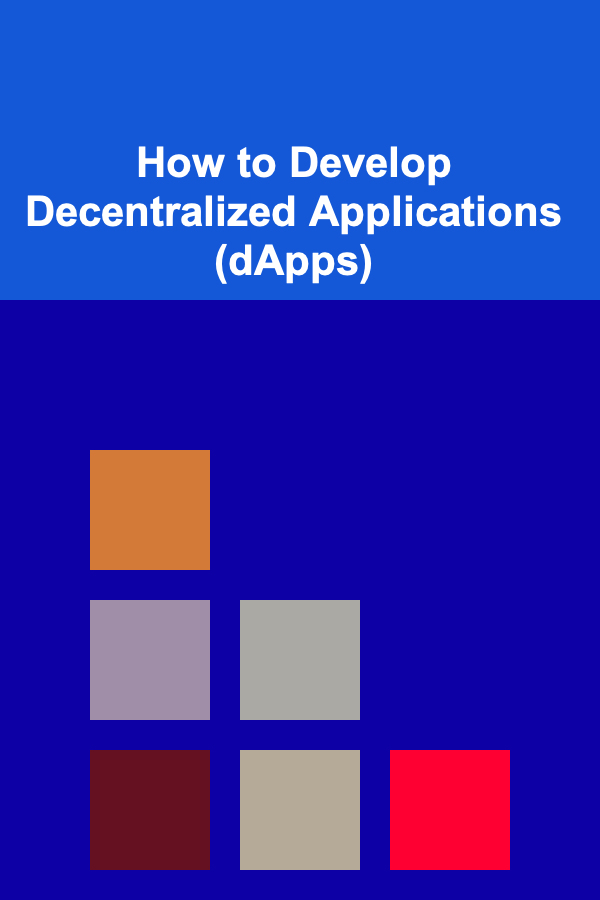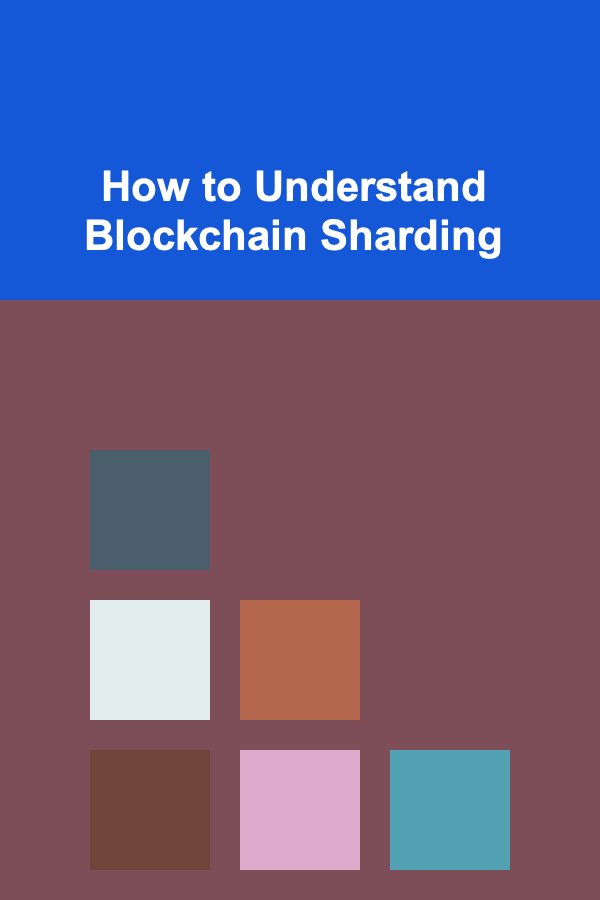
How to Develop Decentralized Applications (dApps)
ebook include PDF & Audio bundle (Micro Guide)
$12.99$8.99
Limited Time Offer! Order within the next:

In recent years, the rise of blockchain technology has created new opportunities for building decentralized applications (dApps). These applications have the potential to revolutionize industries by providing transparency, security, and autonomy. Unlike traditional applications, which are typically hosted on centralized servers, dApps run on decentralized networks, providing a trustless and peer-to-peer environment.
In this article, we will explore how to develop decentralized applications, covering the technical aspects, tools, frameworks, and best practices for building dApps.
Understanding Decentralized Applications (dApps)
Before diving into the development process, it's crucial to understand what decentralized applications are, how they work, and how they differ from traditional applications.
What is a Decentralized Application?
A decentralized application (dApp) is an application that runs on a decentralized network of computers rather than a single centralized server. These applications leverage blockchain or distributed ledger technology (DLT) to ensure that data is stored in a secure, transparent, and tamper-proof manner. Unlike traditional apps, dApps are not controlled by any single entity, providing users with more control over their data and interactions.
Key features of dApps:
- Decentralized: Operates on a distributed network of nodes rather than a centralized server.
- Open-source: The source code is typically open for anyone to inspect or contribute to.
- Trustless: Uses blockchain's consensus mechanisms to eliminate the need for intermediaries.
- Cryptocurrency: Many dApps use cryptocurrencies or tokens as a means of facilitating transactions and incentivizing users.
- Autonomous: Once deployed, dApps can function autonomously without central control or oversight.
Benefits of dApps
- Transparency: Transactions and data stored on the blockchain are immutable, providing a transparent and verifiable record.
- Security: Blockchain technology ensures that data is secure, resistant to hacking, and difficult to alter.
- Censorship Resistance: Because dApps are decentralized, they are less susceptible to censorship or control by any central authority.
- Privacy: Users maintain control over their data, and many dApps prioritize user privacy.
Challenges of dApps
- Scalability: Blockchains often face challenges with scalability, meaning that as the number of users increases, performance may degrade.
- User Experience (UX): Interacting with dApps can sometimes be more complex than traditional apps, especially for users unfamiliar with cryptocurrency or blockchain concepts.
- Regulation: The decentralized nature of dApps poses legal and regulatory challenges, especially in the context of cryptocurrency and financial services.
Building Blocks of a Decentralized Application
To build a decentralized application, you need to understand the core components that make it work. These components include:
2.1. Blockchain
The backbone of a dApp is the blockchain. The blockchain serves as the decentralized ledger that records transactions and stores data. There are several blockchain platforms available for building dApps, with Ethereum being the most widely used. Other blockchains like Solana, Binance Smart Chain, and Polkadot are also gaining popularity.
Choosing a Blockchain Platform
When selecting a blockchain platform for your dApp, you need to consider several factors:
- Smart Contract Capability: The platform must support smart contracts, which are self-executing contracts with the terms of the agreement directly written into code.
- Transaction Speed and Fees: Consider the scalability of the platform, as well as transaction costs, which can vary significantly depending on network congestion.
- Security: Security is crucial, and you should choose a platform that is known for its robustness and has a proven track record.
- Developer Community: A large and active developer community can provide support and resources for building your dApp.
2.2. Smart Contracts
Smart contracts are digital contracts that automatically execute actions based on predefined conditions. They run on the blockchain and are written in programming languages specific to the blockchain, such as Solidity for Ethereum.
Smart contracts play a critical role in dApp development because they allow for trustless interactions between users. For example, a smart contract could automatically transfer ownership of a digital asset when certain conditions are met, eliminating the need for a middleman.
Writing Smart Contracts
To write smart contracts, you need to learn a language such as Solidity (for Ethereum-based dApps). Smart contracts can be complex, depending on the functionality they need to support. Common use cases for smart contracts include:
- Decentralized finance (DeFi): Lending, borrowing, and trading on decentralized platforms.
- Tokenization: Issuing and transferring digital assets like cryptocurrencies or NFTs.
- Governance: Enabling decentralized governance, where users vote on protocol decisions.
2.3. Frontend Development
The frontend of a dApp is the user interface (UI) that interacts with the blockchain. It is similar to the frontend of traditional web applications, but it also integrates blockchain-related functionality. In most cases, the frontend is built using popular web development frameworks such as React, Vue, or Angular.
To connect the frontend with the blockchain, you'll need to use libraries such as Web3.js or Ethers.js. These libraries allow your frontend to communicate with the blockchain and interact with smart contracts.
Web3.js or Ethers.js
- Web3.js: A JavaScript library that allows interaction with the Ethereum blockchain. It provides methods for sending transactions, interacting with contracts, and querying the blockchain.
- Ethers.js: Another JavaScript library for interacting with Ethereum. It is lightweight and easy to use, providing a simple interface for sending transactions and calling smart contract functions.
2.4. Backend Development (Off-Chain)
While the blockchain is decentralized, some data in dApps might not need to be stored on-chain due to high costs or inefficiency. This is where off-chain storage comes into play. You can use a traditional backend server or decentralized storage solutions like IPFS (InterPlanetary File System) or Arweave for storing larger datasets, files, and media.
IPFS
IPFS is a decentralized file storage system that allows files to be distributed across a network of nodes. By using IPFS, you can store large files off-chain while maintaining decentralization and security. Files are given a unique hash that can be referenced by your smart contract, ensuring that the data is immutable.
Tools and Frameworks for Building dApps
When developing a dApp, several tools and frameworks can help streamline the process. These tools assist with writing smart contracts, deploying them on the blockchain, interacting with the blockchain, and building the user interface.
3.1. Truffle Suite
Truffle is one of the most popular development frameworks for Ethereum-based dApps. It provides tools for writing, testing, and deploying smart contracts. Truffle includes:
- Truffle Console: An interactive console for testing and interacting with contracts.
- Truffle Migrate: A tool for deploying contracts to different blockchain networks.
- Ganache: A personal blockchain used for testing purposes.
3.2. Hardhat
Hardhat is a development environment for Ethereum smart contracts. It provides similar functionality to Truffle, including local Ethereum network setup, contract testing, and debugging. Hardhat also integrates well with other tools, such as ethers.js and Waffle, for building and testing smart contracts.
3.3. Remix IDE
Remix IDE is a web-based integrated development environment (IDE) that allows you to write, test, and deploy smart contracts. It is particularly useful for beginners, as it provides a simple interface for working with Solidity and Ethereum.
3.4. Metamask
Metamask is a browser extension that acts as a cryptocurrency wallet and bridge between the frontend of your dApp and the blockchain. It allows users to interact with decentralized applications without needing to run a full Ethereum node.
Metamask is essential for dApp developers, as it handles user authentication and transaction signing.
3.5. Infura
Infura is a service that provides scalable access to Ethereum and IPFS networks. It allows developers to interact with the Ethereum blockchain without running their own nodes. Infura is particularly useful for decentralized applications that require high scalability and reliable access to the Ethereum network.
Deploying and Testing dApps
After developing a dApp, the next step is to deploy and test it. Deployment typically involves the following steps:
4.1. Deploying Smart Contracts
Once your smart contract is written and tested, you can deploy it to a blockchain network. The deployment process involves sending a transaction to the blockchain to create a new contract instance.
You can deploy your contract to various Ethereum networks, such as:
- Mainnet: The primary Ethereum network, where real transactions take place.
- Testnet: A simulated environment for testing, where no real funds are involved (e.g., Rinkeby, Kovan, Ropsten).
- Local Networks: Using tools like Ganache to deploy to a local Ethereum instance for development and testing.
4.2. Frontend Deployment
After deploying your smart contract, you need to deploy the frontend. This can be done on traditional web hosting services like Netlify , Vercel , or AWS , or on decentralized platforms like IPFS.
4.3. Testing dApps
Testing is a crucial part of the development process. For smart contracts, you should write unit tests using frameworks like Mocha or Chai . Frontend testing can be done using tools like Jest or Cypress. It's also important to conduct end-to-end testing on a testnet before going live.
Best Practices for dApp Development
When developing dApps, there are several best practices to follow to ensure security, scalability, and maintainability:
5.1. Security Audits
Smart contracts are immutable once deployed, making them a prime target for hackers. Ensure that your smart contracts are thoroughly audited for vulnerabilities. You can either perform internal audits or hire third-party security experts.
5.2. Gas Optimization
Transactions on the Ethereum blockchain can incur high gas fees, especially during network congestion. To minimize costs, optimize your smart contracts to reduce gas usage. This includes using efficient data structures and minimizing the number of operations in your contract.
5.3. User Experience
dApps can be more complex to use than traditional applications, so focus on creating a seamless and user-friendly experience. This may include integrating with wallets like Metamask, providing clear instructions, and simplifying transactions.
5.4. Interoperability
Consider building dApps that are interoperable with other platforms and ecosystems. This can include integrating with DeFi protocols, NFTs, or other dApps.
5.5. Scalability
As dApps gain more users, scalability becomes a critical factor. Consider solutions like Layer 2 scaling (e.g., Optimism, Arbitrum) or exploring other blockchains with higher throughput.
Conclusion
Developing decentralized applications requires a deep understanding of blockchain technology, smart contracts, frontend and backend development, and various tools and frameworks. By leveraging the power of blockchain, dApps can provide a more secure, transparent, and user-centric alternative to traditional applications. With careful planning, secure development practices, and an eye on user experience, you can build robust and successful decentralized applications that have the potential to transform industries and empower users worldwide.

How to Create a Craft Calendar for Planned Projects
Read More
How to Decorate a Small House on a Budget
Read More
How to Organize a Group Budget for Shared Expenses
Read More
How To Understand the Use of Positive and Negative Space
Read More
How to Understand Blockchain Sharding
Read More
How To Find TV Shows That Feature Magical Realism
Read MoreOther Products

How to Create a Craft Calendar for Planned Projects
Read More
How to Decorate a Small House on a Budget
Read More
How to Organize a Group Budget for Shared Expenses
Read More
How To Understand the Use of Positive and Negative Space
Read More
How to Understand Blockchain Sharding
Read More